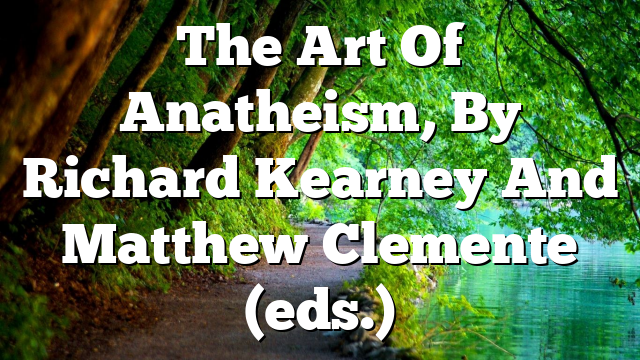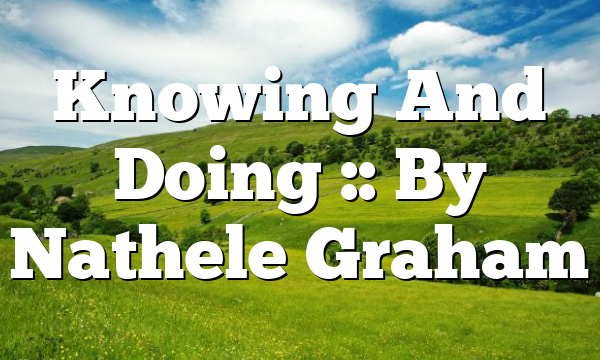Click to join the conversation with over 500,000 Pentecostal believers and scholars
Click to get our FREE MOBILE APP and stay connected
| PentecostalTheology.com



622
Book Reviews
Richard Kearney and Matthew Clemente (eds.),The Art of Anatheism(New York,
NY: Rowman and Littlefield International, 2018). 314 pp. $39.95 paperback.
In his groundbreaking 2010 book Anatheism: Returning to God After God (New York, NY: Columbia University Press, 2010), Richard Kearney offered a com- pelling hermeneutics of religion for a post-secular society. Drawing deeply from phenomenology, hermeneutics, literature, Christian mysticism, Holocaust studies, and moral exemplars, Kearney offers a snapshot of what Paul Ricoeur dubbed a second naiveté on the far side of the desert of criticism. Along with catalyzing the budding field of Continental Philosophy of Religion, this analy- sis is pertinent for those many spiritually restless persons who have had to leave the faith of their youth in order to find it again as adults. In Anatheism, Kear- ney makes the claim that, “Any religious hermeneutics worth its salt needs art if it is to be true to faith” (14). In their new edited volumeThe Art of Anatheism, Richard Kearney and Matthew Clemente among others take up the mandate delivered in this first volume to discover whether or not Anatheism can live up to this task as a helpful analysis of religious painting, poetry, music, and other forms of art. The book is a compilation of articles contributed by philosophers, theologians, artists, pastors, and poets. These essays are organized under five section headings, 1. Anatheism and Theopoetics, 2. Painting Anatheism, 3. Per- forming Anatheism, 4. Screening Anatheism, and 5. Writing Anatheism.
The first section, while addressing particular pieces of art, establishes a theo- retical groundwork for the rest of the book. Richard Kearney recaps his anathe- ist project and applies his philosophical analysis of poesis to Rublev’s Icon of the Trinity, Antonello da Messina’s Virgin Annunciate, and two of Sheila Gal- lagher’s pieces. Next, Katherine Keller and John Caputo provide a recap and overview of the history of theopoetics in their process and deconstructive iter- ations. John Manoussakis concludes this section with what I believe to be one of the strongest essays in the entire volume. He explores the way that the crack in God provides space for a split humanity to participate within the divine life. Manoussakis accompanies his psychoanalytic reflections on religion with a provocative reading of the film Nymphomaniac. He identifies that the cracks in broken human beings can become the caverns through which God’s grace pours.
In the five articles under the banner of “Painting Anatheism” the book moves from text to canvas. Mark Hederman provides a historical overview of Jewish and Christian art which identifies the transformation of artistic style, corre- sponding to the three movements of Anatheism. The artist Sheila Gallagher follows this with a mixture of her own art and the history of gardens. Agreeing with Kearney’s project, Gallagher identifies that in the garden, “there is always
PNEUMA
© koninklijke brill nv, leiden, 2018 | doi:10.1163/15700747-04004025
1
Book Reviews
623
fertility and creativity beneath the surface of barrenness and scarcity (97).” The following two chapters reflect upon Christian and Buddhist art, giving special attention to the crosspollination between high/low and religious/secular paint- ings.The final chapter in this section feels rather out of place given its conversa- tional style, yet for me it was one of the most philosophically illuminating in the entire book. Jean Luc Nancy offers reflections on art, the difference between his deconstruction of Christianity and Kearney’s Anatheism, and personal explo- rations on his own journey with religion in the context of a fruitful interview.
In its central section, “Performing Anatheism” the book takes a melodic turn and demonstrates powerfully that this is not merely an academic concept, but Anatheism is also a profound cultural phenomenon. M.E. Littlejohn explores the anatheist themes that are so prevalent in the music of Bob Dylan, The Beatles, Leonard Cohen, andU2.While none of them explicitly identify as “wor- ship musicians” the concern for hospitality over hostility and the return to the sacred on the far side of disenchantment crop up consistently in the music of these rock and folk musicians. Callid Keefe-Perry demonstrates Anatheism’s recurrences in rap both sacred and secular. By exploring the religious themes in the music of Lecrae, Kendrick Lamar, and Killer Mike, he demonstrates rap’s potential for spiritual protest. Christina M. Gschwandtner follows in this same vein in her essay on the dialogical hospitality of Syriac liturgical poetry. The poet provides room for competing voices and the transformation of violent narrative through hermeneutical charity. The final two chapters explore con- nections betweenAA, Jean Luc Marion, and Kearney’s Anatheism as consonant with one another in their reference to a God beyond that becomes incarnate in the flesh and blood of icons and alcoholics.
In the first essay in the fourth section, Stephanie Rumpza demonstrates the anatheist turns in three contemporary films. In my opinion, the most interest- ing of her reflections pertained to the critique of idolatry implicit in the 2016 film adaption of “Silence” in the training of the gaze of the Jesuit missionary Rodriguez. The next two essays explore the re-emergence of the sacred in the midst of spaces where God is presumed to be dead. In the Netherland’s phys- ical and digital rendition of The Passion, and in Bill Viola’s Emergence one can see that God emerges and re-emerges in the liturgical and artistic lives of even the most secular individuals.
The final portion of the book is comprised of three essays which explore the theme of anatheism in writing. In the fiction of Marilynne Robinson, Andrew Cunning charts the path of a return to God on the far side of pain and disen- chantment. By transfiguring the Freudian concept of the uncanny, Robinson like Kearney identifies the moment of strangeness as the moment of hospi- tality and potentially salvation. Thomas Altizer follows this section by iden-
PNEUMA 40 (2018) 563–624
2
624
Book Reviews
tifying Kearney with a more radical strand of theological thinking that has emerged following the death of God. While questioning whether Kearney may be too Catholic, Altizer identifies in his eschatological poetics the potential for a new Catholic theology that exceeds the previous concepts that have already been discredited before being articulated. Fittingly, the book concludes with an anatheist poem from Fanny Howe that focuses on a “mysticism exhumed of belief.” Those looking for a critical philosophical and theological engagement with the anatheist project, or those unconvinced of Kearney’s assertions in the original volume will likely not be persuaded by this new volume. However, as someone that finds this project to have powerful theological and philosophical significance, this book only expanded my appreciation for the project Kear- ney began in his Anatheism volume. If any religious hermeneutics worth its salt has explanatory power for religious art, then Anatheism has salt to spare. Those interested in aesthetics, religious art, or the phenomenology of religion will benefit greatly from reading the essays in this volume.
Austin M. Williams
Boston College, Boston, Massachusetts austin.williams@bc.edu
PNEUMA 40 (2018) 563–624
3




Most Talked About Today